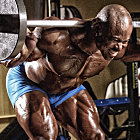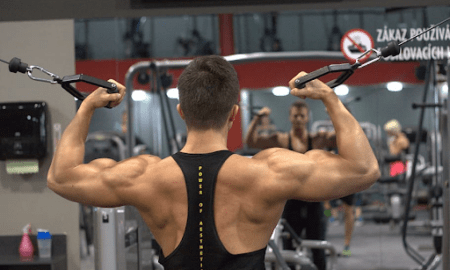 Q: What is your opinion of good mornings? I understand they’re bad for the back.
Q: What is your opinion of good mornings? I understand they’re bad for the back.
A: What I find interesting is that many of the trainers and health-care professionals who condemn the good morning have no problem recommending seated back extension machines! What is a seated back extension except a good morning performed with a machine? So let’s begin by asking whether a seated good morning is a bad exercise.
The seated good morning is performed on a bench (usually the edge of a bench press bench), with the bar held high on the shoulders. While maintaining a neutral spine, you lean forward as far as is comfortable. It should be noted that sitting increases the compressive forces on the spine, so this variation is not normally recommended if you have lower-back issues. Also, you should never perform it by holding the bar in front of your shoulders, because trying to hold the bar on the clavicles in that position places tremendous strain on the rhomboids and rotator cuff muscles.
If you’re a powerlifter, the good morning is a good supplemental exercise—and not just for the deadlift. Modern squatting methods rely more on hip extension than knee flexion, and the good morning is a great exercise for the glutes; the erector spinae, or lower-back muscles; the hamstrings and the adductors. With the change in squatting technique, however, powerlifters tend to perform it with a wide foot stance, which more strongly involves the adductors, and hold the bar lower on the back.
For the deadlift, many powerlifters find that working good morning is more comfortable than doing deadlift variations. The good morning begins from a position of advantageous leverage, as opposed to the deadlift, which begins from a position of disadvantageous leverage. The good morning also involves a countermovement and starts with an eccentric contraction, as opposed to the deadlift, which begins with a concentric contraction.
No discussion of the good morning would be complete without mentioning ’59 NABBA Mr. Universe Bruce Randall, who performed a rounded-back version that was like a regular good morning but with a rounded back. Due to the high levels shearing stress on the lower spine, I cannot recommend the rounded-back movement. That said (and you can find numerous photos on the Internet of Randall performing the exercise), Randall had a best result in this exercise with 685 pounds!
One seldom-used variation of the good morning is the good morning jump squat. As opposed to the conventional jump squat done with a barbell, this variation most closely approximates the motion used at the finish of the power snatch and power clean. You perform a good morning in the regular fashion, but then you jump up at the finish, landing with bent knees. The jump enables you to increase lifting speed dramatically during the extension, thus developing explosive strength. Don’t use this variation if your goal is to develop muscle. Also, this exercise requires considerable skill to master. Perform it only with relatively light weights.
For athletes who want to improve hip-extension strength quickly, I recommend a tri-set consisting of good mornings and other exercises for the glutes and lower-back muscles. The tri-set uses a variety of repetition protocols to exhaust all available motor units. Here’s the program:
A1) Standing good mornings, 4/0/2/0 tempo, 4 x 6-8, rest 10 seconds
A2) Romanian deadlifts, 4/0/2/0 tempo, 4 x 8-10, rest 10 seconds
A3) Reverse hypers, 2/0/X/0 tempo, 4 x 15-20, rest 120 seconds
The good morning has largely been forgotten, but that doesn’t change the fact that it still has considerable value. Consider all the advantages of performing each of the above variations, and choose the one that will help you achieve your goals.
Editor’s note: Charles Poliquin is recognized as one of the world’s most suc-cessful strength coaches, having coached Olympic med-alists in 12 different sports, including the U.S. women’s track-and-field team for the 2000 Olympics. He’s spent years researching European journals (he’s fluent in English, French and German) and speaking with other coaches and scientists in his quest to optimize training methods. For more on his books, seminars and methods, visit www.CharlesPoliquin.com. Also, see his ad on the next page. IM





















You must be logged in to post a comment Login